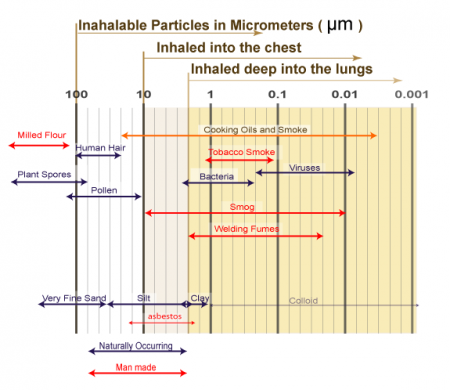Erin Rasmussen, Revised June, 2011
A few months ago Crispin Pemberton-Pigott suggested that we put together a chart of the sizes of various particles that are small enough to inhale and cause problems in the lungs. It was a great idea, and here is the result.
This paper from China, published recently on the link between airborne particles and increased emergency visits is an interesting one, and it's worth a read.
Leitte AM, Schlink U, Herbarth O, Wiedensohler A, Pan X-C, et al. 2010 Size-Segregated Particle Number Concentrations and Respiratory Emergency Room Visits in Beijing, China. Environ Health Perspect 119(4): doi:10.1289/ehp.1002203
Particle Size references:
G. Buonanno, L. Morawska, L. Stabile, Particle emission factors during cooking activities, Atmospheric Environment, Volume 43, Issue 20, June 2009, Pages 3235-3242, ISSN 1352-2310, DOI: 10.1016/j.atmosenv.2009.03.044.
(http://www.sciencedirect.com/science/article/pii/S1352231009002775)
Keywords: Ultrafine particle concentration; Indoor emissions; Aggregate; Size distribution; Cooking activities
Evelyne Gehin, Olivier Ramalho, Severine Kirchner, Size distribution and emission rate measurement of fine and ultrafine particle from indoor human activities, Atmospheric Environment, Volume 42, Issue 35, November 2008, Pages 8341-8352, ISSN 1352-2310, DOI: 10.1016/j.atmosenv.2008.07.021.
(http://www.sciencedirect.com/science/article/pii/S1352231008006535)
Keywords: Aerosol; Ultrafine particle; Emission rate; Source; Indoor air quality
N. T. JENKINS, W. M.–G. PIERCE, AND T. W. EAGAR Particle Size Distribution of Gas Metal and
Flux Cored Arc Welding Fumes Welding Journal October 2005 156s - 163s and http://www.aws.org/wj/supplement/10-2005-JENKINS-s.pdf
C.V Raiyani, S.H Shah, N.M Desai, K Venkaiah, J.S Patel, D.J Parikh, S.K Kashyap, Characterization and problems of indoor pollution due to cooking stove smoke, Atmospheric Environment. Part A. General Topics, Volume 27, Issue 11, August 1993, Pages 1643-1655, ISSN 0960-1686, DOI: 10.1016/0960-1686(93)90227-P.
(http://www.sciencedirect.com/science/article/pii/096016869390227P)
Keywords: Polycyclic aromatic hydrocarbons; particle size distribution; gaseous pollutants; biomass fuels; fossil fuels; traditional biomass stove 'chulha'
J. W. SOWARDS, J. C. LIPPOLD, D. W. DICKINSON, AND A. J. RAMIREZ Size and mass distributions, fume generation rates, and chemistry
are compared for three SMAW electrodes, The Welding Journal April, 2008, Vol 87 106s-112s http://www.aws.org/wj/supplement/wj0408-106.pdf
Smog: 0.01 to 10 microns See Figure 1 http://capitawiki.wustl.edu/images/5/54/71j1.pdf
Human Hair: 40-100 microns (wikipedia)
Milled Flower: hundreds of microns to millimeter: http://www.sciencedirect.com/science/article/pii/S0963996900001265
Plant Spores: 90- hundreds of microns http://www.sciencedirect.com/science/article/pii/0034666787900674
Tobacco Smoke: 0.1 to 1 micron http://www.afssociety.org/education/0710oneminute.html
Pollen: 10 to 100 microns http://www.vcbio.science.ru.nl/en/virtuallessons/pollenmorphology/
Viruses: 20-400 nm (0.02 to .4 microns) http://abyss.uoregon.edu/~js/glossary/virus.html
or 0.005 to 0.1 microns http://2the4.net/paartbact.htm
Bacteria: .2-5 microns http://2the4.net/paartbact.htm
Sand Silt and Clay: http://en.wikipedia.org/wiki/Particle_size_%28grain_size%29
Wood smoke particlesnext term are found mainly in 0.06–0.1 µm range with PM1 of 90% of PM mass.: Md. Aynul Bari, Guenter Baumbach, Johannes Brodbeck, Michael Struschka, Bertram Kuch, Werner Dreher, Guenter Scheffknecht, Characterisation of particulates and carcinogenic polycyclic aromatic hydrocarbons in wintertime wood-fired heating in residential areas, Atmospheric Environment, In Press, Corrected Proof, Available online 15 December 2010, ISSN 1352-2310, DOI: 10.1016/j.atmosenv.2010.11.053.
(http://www.sciencedirect.com/science/article/pii/S1352231010010241)
Keywords: Wood-fired heating; Particle size distribution; Wood smoke; Particulate PAHs; Particle morphologyNike Air Force

